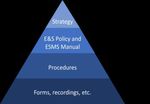Sustainable finance and Tropical Forestry - SPOTT.org
←
→
Page content transcription
If your browser does not render page correctly, please read the page content below
April 2021
Case study #6
Sustainable finance and Tropical Forestry
Supporting sustainable development in the
timber and pulp sector
Development Bank of the Central African States
The Development Bank of the Central African States (BDEAC) is the development bank of the Economic
and Monetary Community of Central Africa (CEMAC), which member states include Cameroon, the
Central African Republic, the Republic of Congo, Gabon, Equatorial Guinea and Chad. The BDEAC was
created through an Agreement signed on 3rd December 1975. It started its operations on 3rd
January 1977. As of December 2019, its authorised capital amounted to XAF 1200bn (over €1 .83bn).
Scope of activities
The role of the BDEAC is to promote the economic and social development of the CEMAC
member states, in particular by funding national and multi-national investments and projects
for economic integration. It supports member states, sub-regional organisations, and
economic operators in funding feasibility studies for programmes and projects, and in their
efforts to mobilise financial resources and fund projects.
Sustainability and supervision of financial activities: the ESMS
The BDEAC has developed an Environmental and Social
Management System (ESMS) to identify and control E&S
risks (and opportunities) associated with its prospective
clients and potential projects, in particular cash flow
risks, guarantee risks and reputational risks. It is based
on the BDEAC's five-year Strategy and E&S Policy1.
The scope of the ESMS covers the entire funding cycle,
from project identification to the closing of the
commitment with the borrower (e.g. payment of the last
instalment by the project holder).
All financial products, including loans, project funds, guarantees, and majority or minority
shareholdings, fall within the scope of the ESMS.
1. For more information about the BDEAC’s five-year Strategy and E&S
Policy, please refer to the “Further Reading” section of this case study.Timber and pulp activities eligible for funding
Activities related to the management of, and operations in, planted and natural forests, as well as
the processing and transport of forest products, are eligible for BDEAC funding.
However, the following are excluded :
• any operation involving or requiring the destruction of critical habitats or ecosystems
• any commercial logging of a primary forest
• any forestry project that does not implement a sustainable development and management
plan
ESG risk categories
The process of analysing the E&S risks associated
with a funding request starts at the phase of Risks and impacts
identification and preparation of a potential
Investments associated with high E&S
transaction, and intensifies during the evaluation
risks have the potential for significant and
phase.
irreversible impacts.
E&S risk levels are calculated based on the
Medium E&S risk investments present
transaction risk, which depends on the type of
limited E&S risks and/or have the
funding, its amount and duration (e.g. a long-term
potential to cause few, generally site-
loan or equity investment is more risky than a short-
specific, and largely reversible impacts
term credit line), and the customer risk.
that can be readily addressed through
The customer risk depends on the sector the activity mitigation measures.
belongs to.
In the timber and pulp sector, most investments are deemed to be high or medium E&S risk.
Fig. 1 : BDEAC due diligence requirements for each E&S risk levelImplications for companies requesting funding
Projects associated with the highest E&S risks — as this is often the case for projects in the
timber and pulp sector — require full due diligence.
With an external consultant, it should include at least the following:
• An E&S documentation review
• A review of the reputational E&S risks
“ The BDEAC believes that its financing decisions
must be mindful of both its market share and its trust
of the client or project under share — i.e. its environmental and social requirements.
consideration (based on publicly The BDEAC can refuse a project with satisfactory solvency,
available information) liquidity and financial profitability, if the project has not
• A detailed compliance review of the met the required social and environmental sustainability
ESIA (if not finalised in the previous requirements. It can also declare that loans are ineligible
phase) when a borrower does not comply with its E&S
specifications. _
• An E&S interview with the client
• A site visit Guy Djombe
”
• The formalisation of an E&S due Head, Environment and Sustainability Operations Division
diligence report including a summary DEVELOPMENT BANK OF THE CENTRAL AFRICAN STATES
and an E&S action plan (ESAP)Call to action
The BDEAC encourages its prospective clients to apply good E&S risk management practices, energy
efficiency, clean technologies, and renewable energy. E&S commitments will now be included in loan
agreements, to ensure that E&S risks are monitored and associated compliance is addressed by
borrowers.
Further reading
• BDEAC’s five-year Strategy 2017-2022 :
https://www.bdeac.org/jcms/pre_27837/en/plan-strategique-2017-2022
• BDEAC’s Environmental and Social Policy:
https://www.bdeac.org/jcms/pre_27972/en/politique-environnementale-et-sociale-de-la-banque
ZSL would like to thank Guy Djombe for preparing this case study.
Developed by ZSL (Zoological Society of London), SPOTT is a free, online platform supporting sustainable
commodity production and trade. By tracking transparency, SPOTT incentivises the implementation of
corporate best practice. SPOTT assesses commodity producers, processors and traders on their public
disclosure regarding their organisation, policies and practices related to environmental, social and governance
(ESG) issues. Investors, buyers and other key influencers can use SPOTT assessments to inform stakeholder
engagement, manage ESG risk, and increase transparency across multiple industries.
The SPOTT initiative is funded by UK aid from the UK Government, however, the views expressed do not necessarily
reflect the UK government’s official policies.You can also read






















































